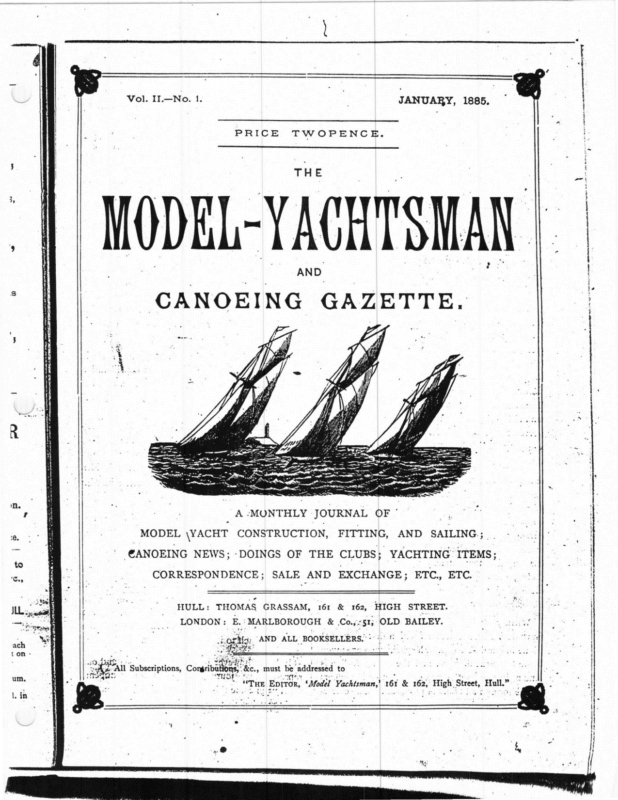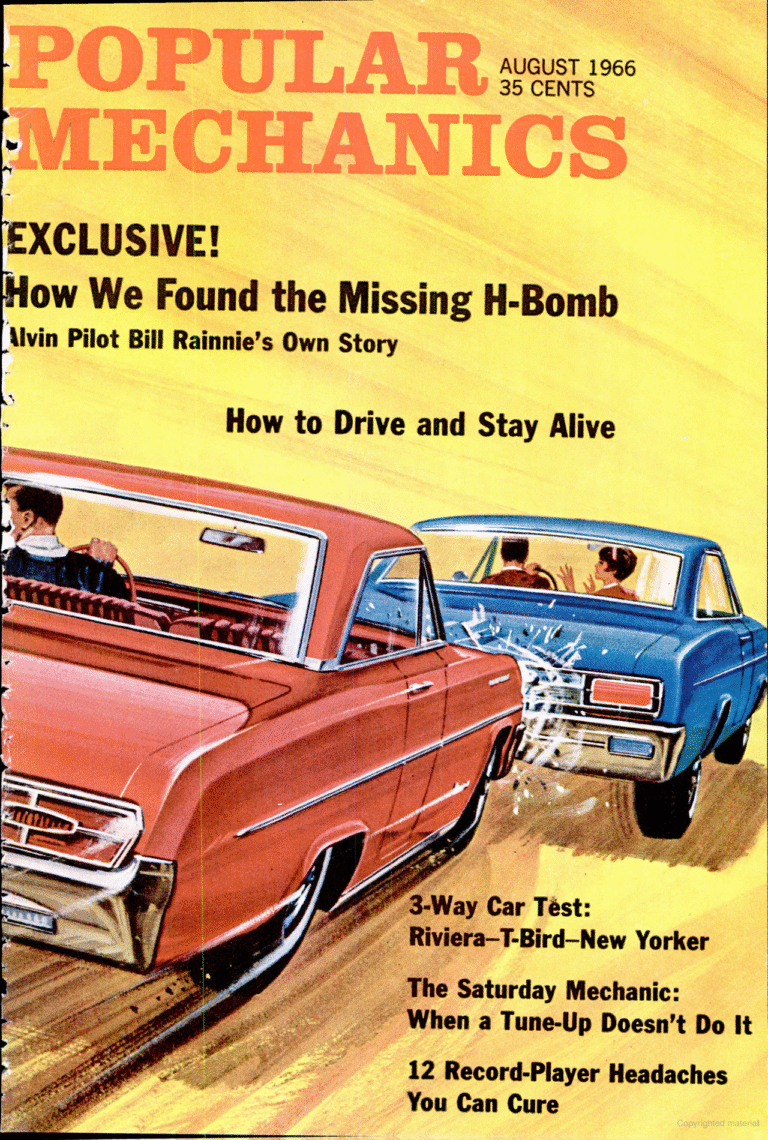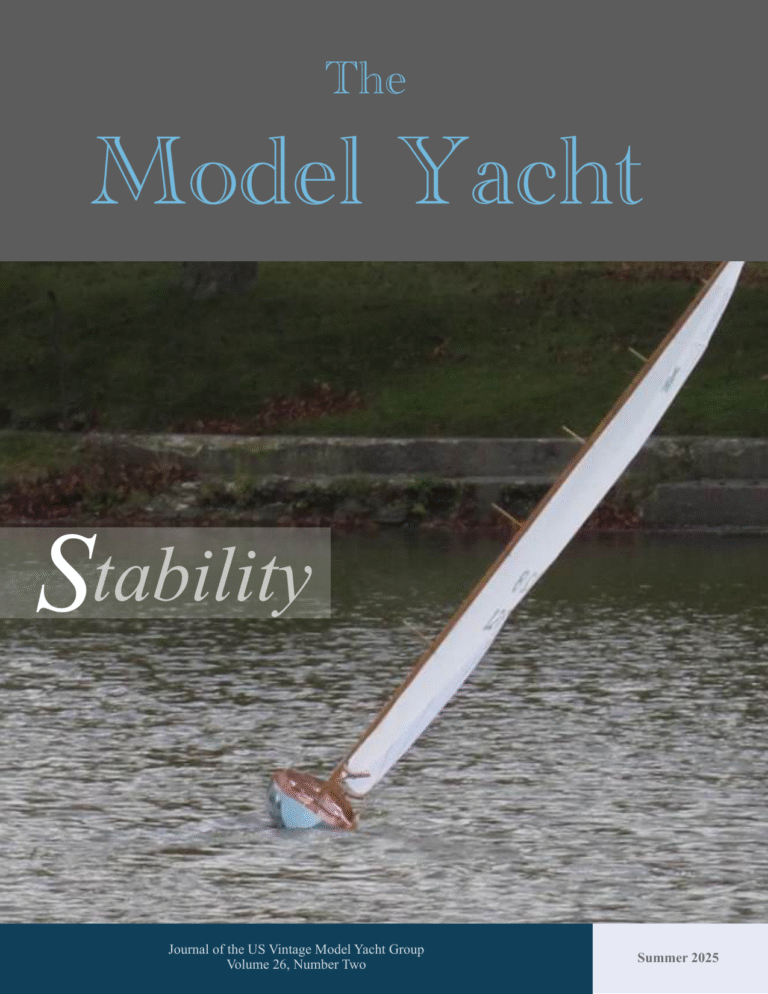Vol. II.—No. 1. JANUARY, 1885. PRICE TWOPENCE. THE AND ! Ae CANOEING GAZETTE. os Least ea eA a he le eS EE.CSUR ge EET zi Te ee MODEL-YACHTSM A MONTHLY JOURNAL OF ‘ MIT MODEL \YACHT CONSTRUCTION, FITTING, AND SAILING; ‘€ANOEING NEWS ; -DOINGS OF THE CLUBS; _ YACHTING ITEMS ; CORRESPONDENCE ; SALE AND EXCHANGE; ETC, mac HULL: THOMAS GRASSAM, 161 & 162, HIGH STREET. LONDON : E. ‘MARLBOROUGH & Co. 51; ceeun BAILEY. gto. AND ALL BOOKSELLERS.” 29.par raSaiSubscriptions me : Bs a» 3 2 oc congrivatiet &e.ss shest be.“addresied to ‘ “Tue® Epivor, ‘Model Yachtsman,’ 163 & 162, High. Street, Hull atte poke Os A .
——$— – _— ——. in respect to the pastimes for which we labor, and the good fellowship and kindly feeling they are calculated to spread amongst all who participate in them. So far as our efforts are concerned it will not be our fault if these wishes do not bear fruit, as we shall make increased efforts to swell the number of followers of model yachting and canoeing, and our journal will be always devoted to bring the various sections into nearer fellowship. DuRING the past year considerable strides have been made towards this end, the various model yacht clubs having approached each other both in person and through the medium of our columns, nearer than has been the case heretofore, and we hope the coming year will see a still greater advance – in this direction. An United Kingdom regatta has been. held, under the auspices of the Liverpool club, and although not so numerously attended as it de- ed to be, we look forward with confidence to a good gathering in 1885. aaa TuA difficulty of classing boats so widely differ- ent ag the length classes and the tonnage classes is one paramount obstacle to complete satisfaction, en Te SP mew Ln nee ern ig ieee yt ee ee but wherever model-yachtsmen meet they must be prepared to give and take according to the best ‘ arrangements which can be made under the cir- cumstances. Whether we shall ever get an universal classification that all may work to, is a question only the future can answer, but it is devoutly to be ‘ desired that it may be accomplished as soon as possible, that all may compete on even terms. – o— WHILsT on this question of. measurement, we must derive some little consolation that we are not alone in our differences. The yachtsmen are much more exercised than we, and theAstrong feeling is finding its usual outlet in the /7e/d and other papers in the form of all kinds of proposals. One corres- – pondent we notice suggests the advantage of setting “t 7 — — We brought this suggestion forward _ ourselves some time ago with regard to model yachts, penalising deviations from the ideal by forcing _them into other classes higher or lower as the – case might be, but model yachtsmen not having ee perous in all their circumstances, and especially so , mm happy and prosperous new year,—happy and pros- Y.R.A: time allowance. much competition with boats of other clubs did = to bear to all our readers our best wishes for a | te eae IN issuing the first number for-1885, we wish it up some ideal type of yacht, having defined length and beam, all deviations from this to be rated by not seem prepared to make any: departure whatf ever. THE great cry of dissatisfaction re | Uotes. tN ate Godituvial MODEL-YACHTSMAN. concerning yacht measurement has once more.touched the Fak, RANA AO eR THE nerves of that august body the Y.R.A., and it is announced they will take the matter into their consideration, . We doubt whether any alteration will form a basis for model yachting reform, but. must wait the issue before deciding. —O— PERHAPS some of our model yachtsmen will take the subject into their earnest consideration during the winter when the attractions of matches are absent, and formulate some rule that will bring our.various types into equitable competition. ” The formation of a2 Model Yacht Racing As- sociation, would most: probably be. the’ likeliest step to bring about an advantageous change, and we shall not discontinue to advocate this idea — until satisfied that it cannot be converted into an. oe ; accomplished fact. = Oise Ir is satisfactory to note that our Journal is gradually finding its way into the various districts . where model yachting is practised on the continent. Our standing register of the clubs and*the reports of their matches, etc , cannot fail to convey to the’ people there the business like manner in which the sport is carried on here, and the importance and it needs but the crowning act. it has reached, of the formation of the M.Y.R.A. to put thefinishing touch to its imposing effect. IN spite however of our organisations and our representative journal, they on the continent, excel us in some things, one of which is the model – yacht matches that accompany some of the yacht a 6. –
(7 guns). who being the red ensign. engraving of a Nautilus with the inscription, ‘The the Art itself is Nature.” the shore. corrected to 1854.” Counsel, Treasurer, Hon. Sec:, Cup Bearer, -Audi- Regatta LL LOLOL shall be glad yachtsmen in any to receive from model- part of the world, particulars LLL of clubs, matches, or model yachtingin general. -o-— A HIGHLY instructive and interesting article on MELLEL — tors, Librarian, Sailing Committee, & Flag-maker; ‘and then the Club Stations. “Canoes, and how Stansfield Hicks, Own Paper. to build them,” by C. is now appearing in the Boy’s It commenced in the special page is devoted Following this, a to what is called the Fundamental Rule; it runs: been passed at a meeting June 7th, 1852, That pleasure yachts not exceeding five tons shall be admitted into the London M. Y. C. as sailing models, it is here laid down as a fundamental rule to which every new member is expected to sub- monthly number and is illustrated by instructive scribe, &c., and which shall never be rescinded but for building the Rob Roy Canoe, etc. by unanimous consent,” &c., &c., and other: binding conditions are here laid down’which goto shew’ —o— It is with pleasure we add to our list of clubs, the Kensington, which has just been formed. The in our: view that the greater and most -influential part of the club had in reality turned their back on. . measurement will be first-class, 36in. on l.w.l1., 6in. model yachting, and feeling the insecurity of their counter; second position in sailing 5-tonners as models, were deter- counter. The opening races will take place in class, © 3o0in. on lL.w.l., 4%in. ‘ January, and next. month we hope to give full information of its doings. HISTORY mined no one should join the club who was not . prepared ta subscribe to their revolution of the original constitution of the club. The General OF THE (First) LONDON M.Y.C. thirty two. Rules follow next, and number They are very. ample in. expression, attempting apparently to govern every situation N our last issue we drew attention to the exist- that is likely to arise; among other regulations rts ” ence in bye-gone times of a Model Yacht Club being particulars of the club uniform, and winding -he with the above ‘title, and promised to give some up with an exordium to the members to promote particulars of it ; and as by favour of our correspon- the stability and respectability of the club. act the DA: ice eras s 7 ich oe nt. dent we have a copy of the rules beforé us, we are~’|” enabled to give a few details in addition to’ those . furnished in the accompanying letter. The Book of rules is about the same size as many of those in use by the present Model Yacht our Clubs, is bound in cloth and inscribed with gold ent, letters on: the cover “ London Model Yacht Club.” del The first objects of attraction ° “ A resolution having December plates of the canoes of foreign nations and designs Tete eemmewenden enon Commodore, Vice and Rear Commodores, Standing inconsider- —_—oO— We Nextcomes thelist of Officers, renee ‘There are many places where this committees take the hint! CAE Also, ‘“Lawsand Regulations of the London Model Yacht Club, instituted 1846 eek Oem as. be nlled with a model inside are‘the ~ Pr- well _ might a. interim yacht regatta, to entertain the spectators who line could be done, and it would afford no eea. The next page shews an of the sightseers can view only the start and finish, able attraction to the day’s proceedings. cts ° ‘These four having the Club device, a Nautilus under sail, on red ground ; the other flag ee ‘ fact that at most of our yacht regattas the majority | Rear-Commodore i dee nina rain ere tin ne aes dn committee, guns), nae yacht regatta offer the prizes for competition, and considering the (9 Baa ba a ware aeneansneerd of the Club Flags, being Burgee, Commodore (11 guns), Vice-Commodore Next come the,Sailing Rules, and these contain so much matter and so many items, we are afraid many of them would be elbowed out of practical existence by pair fellows and the fittest only could survive. Finally, we have the Bye-Laws, regulating the ! behaviour of the members, the use of which would reduce yacht racing to the sobriefy of a funeral ae auspices 3 Gln als SOA ey We do not mean the models accompany the yachts, but the matches are held under the Py OOS 0s theo ea SSP ee regattas. 2 Se THE MODEL-YACHTSMAN.
yachtsmen. With these few remarks we will leave the deceased “* London” to the description of our correspondent, for whose communication we are much obliged, and hope that we may be favored with old histories or reminiscences from other friends. (Cepy.) To THE EDITor. DEAR SIR, on. and extended, and the title adopted of the “London Model Yacht Club.” Only one class of models was recognised, measured thus:—length at 24 of the height from rabbet of -keel multiplied by beam, the product to be not less than 800 or more than 1000 inches. The club rose rapidly in numbers, to about 80, and was immortalised by Charles Dickens, in an article in Household Words; 1:am sorry I do not know the date, but it was between ’48 and ’54. Now came the mistake which destroyed the club. Most of the officers and some of the members had small yachts on the Thames, and after much opposition on the part of the model owners proper, new classes were added, one of 5 tons and one.of 12 ft. waterline. = ‘This took many of the active members away was a previous “ London Model Yacht Club,” allow me as one of the fathers of model yacht sailing to give you a brief history of it and the early days of the sport. ‘My recollections of M. Y. sailing reach back to about 1827, at which time about a either as owners or crew, the model sailing declined, dissensions arose, some of the larger craft-owners joined the river clubs, such as the Royal London (then called the Arundel), or the Prince of Wales; and the London Model Yacht Club passed to its rest. T have often wonderéd why the old title was dozen boats used to sailon the Reservoir at the The sailing days were Sunday morning and Monday afternoon, in those days Saturday half-holidays being a thing unknown. The Sunday sailing always concluded in time for the sportsmen to get a glass of ale before the public houses closed for Church time, about 11 o’clock. The boats were 2ft. 6in. or 3ft. long, dug out or clinker built. No regular matches was the “ Serpentine Saihing Soctéty,” the word “club” not then having come to thétfront. By this period the boats had improved in size and appearance, and were about 4¥%4ft. on l.w.l., and mostly ~ not taken up before, but better late than never, and from what I personally know of. some of the members of the new club, I have no doubt. it will be carried on with spirit, and also with what is were sailed, but two boats would start together for a trifling wager, and this constituted the competition. The builders were nearly all mechanics, and mostly shoemakers. About 1834, the pond was altered and surrounded by railings, which compelled the model-yachtsman to follow his amusement on other waters, viz: the Serpentine, Hyde Park. On the Serpentine we were not allowed to sail after bathing time, 9 a.m., afterwards extended on Sundays to Ioam. At this time little sailing took place during the week, but later on, (I think in 1838) it was proposed to sail a sweepstakes once a month on Monday afternoons. This created a necessity for some kind of rules to regulate the proceedings, and one of our number, Tom Davis, volunteered to draw aset up. I mention his name as he was ‘the original author of M: ¥Y.C. Rules, many of which are in force at the present: day, and the rules. were adopted at what was probably the first Model Yacht Club meeting ever held. The title adopted Silver cups were sailed for whenever the – funds would allow of it; the old rules were revised © -As you evidently are not aware that there corner of the Green Park, London. EDEL LLL AL AON to the good sense and courtesy of our model- the writer was one) and other things were decided equally essential to success, that gentlemanly feeling which would rather waive a point than _ cause a dispute. Yours truly, G. T. SANDERSON, M.Y.S.A.” Reading between the lines of this very in- teresting letter, it seems to us this once flourishing club fell a victim to the selfishness of its more affluent members. Had the leaders of the club : been more considerate of the rank and file, we should most probably have -had this ancient institution flourishing amongst us at the- present day, the most powerfal and most interesting of all the model yacht clubs. ‘ We believe that so long as committees rule . their clubs for the benefit of the sport. they have little to fear on the score of losing their members or running their barque aground, but should’ they | in their own interest or to follow their own ideas, ‘ be too exclusive in their legislation, they will run. . the risk of destruction the same as the “Old London.”—EDITorR. eS . decessor and it speaks in favour of our later demeanour that something «f latitude can be left A6 Re regulation of its members’ behaviour as its pre- emen wens oF. not found it necessary to attempt such austere carvel built. In 1845, Mr. W. Gilbert proposed that a regular club should be formed, with an annual subscription of 6s. This was accomplished, and a club-house, flag-officers, (of whom: pNGAE dre Aare Rem Weare glad that the new “ London” has – eT almost. . THE MODEL-YACHTSMAN DS 4
THE MODEL-YACHTSMAN.. IT. ‘THERE are few boys who do: not at some from many. Now a boat of a very yachty type would be even to be trusted to sail it in the water-butt or fact, what takes his fancy most is In something cistern at the back of the house, for fear he should inclined to be fat and jolly looking, and if it has over-reach two heads, that is comes to a point at either end,- involuntary In such cases of infantile pre- – These ideas being prevalentin this case, are the greatest convenience we could have, as they times betrays no mean knowledge of the position enable me to describe a model that will be in which a boat sails, as he tows her across the attractive, will sail well, look well; and not weigh hearth-rug’s ruffled surface, this latter being skil- too much. fully arranged to imitate the rolling wave. _ he likes it none the worse. The boat I am going to describe, may with ‘ will try the endurance too much to be comfortable, article, as the toyshops may be safely left to- and may in the outset disgust the builder so much provide for their wants. as to impel him to throw it aside, when its most I will content myself with owning my respect for even this form of probable fate will be to come under the house-. yachting, and pass on. to assist if possible those maid’s hands and serve to kindle a fire for break- fast; and as I wish all who begin operations under -. can be trusted to go to the pond side by them- _my directions to make a success, I will recommend- – , boys who, having arrived at such an age that they ‘ butt or cistern, I shall not however devote this patience be cut outwith a pocket-knife, but this mode of procedure I shall not recommend, as it| . those who have attained the dignity of the water- ee a an Am ene acquire + himself and who having a fondness for a boat can persuade their parents or relations to make them a model and help them to sail it. I hope to make it clear to those who have boys and wish them to possess a boat that will sail, that which I think will secure it. The requisite tools will be a 34 inch cutting~ chisel and 34 inch medium gouge, and with ‘these two weapons and some sandpaper I think we can. accomplish the task set before us. The first thing to be considered is the size of” that making one is not a matter of great difficulty, boat, and as some very pretty sailing can be sf! and wish by this means to assist our boys to a out of a 20in. model, I will adopt that as: the- rudimentary knowledge of model yachting: a thing length, 7 inches as the beam, and 3 inches as the that can never be learned from the. usual toy-boat. depth. Indeed, I look upon the toy-boat as‘ one of the pine 3in. x 7in. x 2o0in. planed up smooth and> model yachting, as our youths gather from their a line down the middle of angled square: Draw the top of the wood, carefully ascertaining that thereis exactly the same breadth at either side, continue the line down’the ends and also at the” in the way of sailing can be got out of small models. . This notion is entirely erroneous, and some very good sailing indeed can be obtained by a properly made and fitted model of a small size. “i « Go to some jbiner and get a- piece of ‘yellow greatest enemies to the cultivation of the sport of performance that nothing much : boys ~ iad selves to sail a boat, or on the other hand, those ‘ TS et A OY Hf oD ee CYTO NTR tA TMP ES: CS OES Te shape and rig just such as a boy would choose would say ‘‘Oh, that one would tipple over!” For the benefit of these tiny craftsmen, and for ee extent voted by the ordinary youngster aS too thin; he dilection for sailing his own craft, our little one oft- ae must to some early, so early in fact that the wee navigator has ‘head foremost. Se a I scarcely arrived at years sufficient to entitle him test of. his own ‘powers of flotation by falling in Sa boys, ee ee Oe ey EP ne The desire with some sets in very ° of our pander to their ideas, and advocate something in eu Ne Se time or other have an ambition to possess a model boat. aspirations EIT MAKE In selecting the style of boat likely to suit the underneath side. If all the lines meet at the . corners of the wood—all right, if they do not~ t ee TO ¢ ee rae ema e ie THE BOYS’ BOAT, AND HOW ae
A Tur. : 6 THE MODEL-YACHTSMAN. you are wrong somewhere and must go over them again until they are right. When this is done, turn to the illustration page, take a. piece of stiff paper and‘cut out the shape of the deck as shewn there, the head you will notice being cut a – sharper than the stern. little It is best to cut the shape of one side only at first, from the centre line to the side curves and draw both on the wood from the same piece of paper, this will ensure them being both alike. Draw the deck shape on the underside in the same way. the Next, draw a line on underside at each side of the centre” line, parallel to it, at a distance of rin. “These two _lines:will be two inches apart. Then mark in the gradual taper from these lines to each end of the boat as illustration). shewn in the shape of keel. (see You can now cut off with the gouge and chisel the wood until the shape all the way down from.the top to the bottom is the same shape as the deck plan, and in the next number of this paper must take. I will give the shape the sides a (To. be continued. ) SAIL-PLAN FOR CUTTER. ( See- Lilustration, ) THE sail-plan shown in the diagram this month, the sheet-ropes full purchase, the strain being on the centre of the jib, or near the centre of effort of the sail. Next comes the foresail, the cloths of which have the usual run. This sail has the most leverage power, it being hauled nearer the centre of the boat, and keeps the yacht’s head from running into the wind. The sail put up next is . the jib-headed topsail. It is generally hoisted up first and then the tack: bowsed well down. The leach of the topsail runs to the peak of the gaff. The next sail is the jib-topsail. It is in front-of . the mast, is much the same shape as a jib, only it is hoisted to the top of topmast. instead of mainmast as the jib is, and the jib-topsail sheet-ropes come away to the counter. Now comes the spinnaker-boom, which is marked in the drawing as (1), and it has two guys marked (2), one runs to the stern and the other to the stern. The spinnaker-boom topping-lift, which is hauled up | the boom to the top of mainmast, is marked (3), and the next rope is the out-haul marked (4) used for hauling out the spinnaker-sheet, which ends. the sails in racing models. You should have no. deck fittings such as skylight, companions, or hatches, because they are only encumbrances and top weight. Masts and spars should be as light as possible, with good strong stays. PRIMA DONNA. * @Manoeing. | [N opening this column of our paper for canceing, . we do not pretend to stand in the same position, ° to that sport as to model yachting, the latter being is one which is got up with care and exactness in our special study, and its propagation and perfection . shape; is also simple and easy to take a pattern’ from, the simplicity being the designer’s main | the reason of ourexistence. Yet as all participators feature, so. as to give the amateur the benefit as – in aquatic sports feel a kind of sympathy one with » well as the professional of having good sails. In the first place, sails ought to be as flat as a board, so as to make every inch of cloth tell, especially in the other and have a desire to see all successful, we feel we cannot do better than enlarge the scdpe, of | a beat-to-windward. The first sail generally hoisted is the mainsail. The sail should be sewn in small hems (known to yachtsmen as ‘‘Cloths”), they are shown in the diagram marked (a). These hems or.cloths keep the sail from stretching and our paper by devoting some of its space to a better stiffen the sail. Another feature in sailmaking is, not to make your sail the exact size at first. Keep within-your boom and peak by an inch or so, and through time and the nature of the cloth and it getting wet, you will have it big enough. A rule followed by yachtsmen is, when their race is done, to slack the sails both at the peak and foot of * boom, (B):so as not to stretch the -sail, and you should always try when your sails gfe wet to get them dried at once; by so doing“you may keep your sails in proper shape. The next sail is the jib, which you will see in the diagram has a paper and model yachting in general has received from canoeists, and although we may. not prove of curious run for the cloths. This style of jib gives understanding of-so healthful and scientific recrea- tion as canoeing. We are also induced to take this course in part acknowledgment of many favors this . equal value to both yet it is our desire to. be of what, ‘ use we can to both. To this end we cordially in- vite canoeists all over the world to make use of our columns in any way that may be of value to,theta . selves and their sport, and should we find that our . | offer is taken, advantage, of, and-that the support of | canoeists. becomes an element in increasing the circulation and usefulness of our, paper, we. shall..not *
| FHLNVSHOA-13GOW CNYv O‘N”AILFZVD
‘ eo ‘ Aa ;
EE 116 aes ne THE MODEL-YACHTSMAN. \ Gxchange & Sale Column. RULES. The charge for inserting advertisements in this columnis . Adi. for‘twenty words, and 1d. for every additional five words or portion thereof. Name and address when published are counted in and charged for, and if a number at this office-be given instead, Id. extra for each advertisement is charged. 44d. or Id, stamps may be sent in payment. Advertisements must be written on one side of the paper only. REPLIES.—In-replying to numbered advertisements, the answer must be sent in a blank envelope, sealed, with the number of advertisement written on the corner, also a Id. stamp (not affixed), these to be enclosed in another envelope directed to ‘‘The Editor, ‘A/odel- Yachtsman,’ 161 & 162, High-Street. Hull,” who will direct and forward the envelope containing the reply to the advertiser. _ Please observe that the stamp must sof be affixed to.the « envelope containing reply. No post-cards forwarded. A3-—Splendid Model Cutter Yacht, nearly new, a handy boat and fast sailer, pretty counter, 8 Yiin. beam, price 45/-. A4.—3 ft. Model Yacht for sale, cheap, in good condition. A5.—Model Cutter, not been sailed, everything new, war- ranted to sail well. —30/-. . A6,—First-class Model Racing Cutter, (by good maker) nearly new, spars and sails complete. Length overall 3 ft. 6in., beam 7 Zin. (slightly under ro tons.) Offers. FOR SALE.—CANOE, rsft. x 2ft. gin. beam, Sailing and Paddling. .Complete outfit. Good condition. Price 44.—Apply to A. Grassam, at this office. MODEL DOCKYARD. FITTINGS OF EVERY DESCRIPTION FOR MODEL YACHTS. : eS PRICE _LISTS FREE. LA YLOR BROTHERS, 820,SERAND. STREET, a _LTVERPOOL. MODEL RACING YACHTS. WARRANTED ‘FAST SAILERS. AT MODERATE PRICES. Best American Canary-Wood Laths, 1 inch wide. The best wood – building Model Vessels, and the easiest to work. Straight-Grained. Hungarian ih Battens,— The lightest-and strongest Spar-wood for Models. ~ Complete Sets of Polished Spars, to order— (without fittings.) Enamelled,. Lined and. Polished Deck Wood or Decks, to order. ae, : ” Kosh, No. 1, this nieces . Blocks, Deadeyes,. Wheels, Skylights, Flags, FITTINGS FOR MODEL BEL SHIPS. LISTS FREE. “MODEL: STEAM-ENGINES, Cylinders, Pumps, Guages, Safety Valves, and all the Separate Parts. Microscopes, Telescopes, Chemical Gheats Magic Lanterns, anne, Ralionn’ &e. STEVENS MODEL DOCKYARD,22, ALDGATE, LONDON. .. SEND 32; FOR ILLUSTRATED CATAL CATALOGUE, 100 ENGRAVINGS. . Double Ball Stanchions ………… — E -STEAMBOATS. H. BUTCHER, ~ a – Best Blocks and Deadeyes……… 6d.: per Dozen. Sailing Yachts from 1/- to £8. CUTTERS, SCHOONERS, BRIGS, @ MODEL YACHT BUILDER — and: Practical Boat – Sailer, rae 7, BEDFORD TERRACE, CHURCH- ST., KENSINGTON, LONDON, W. Maker of the Fastest Salling”Boats in London. eo CUTTERS, SCHOONERS, YAWL8, LUGGERS, as, Sent To Aut Parts. _ Boats‘‘Rigged and Repaired on ‘the: Shortest,Notice, ty aya caine &. Grassam, Printer, is prepared to execute orders for Printing, Withography, &c., in the best étyle,. and at moderate prices, ESTIMATES GIVEN. * Wel & 162, HICH ‘STREET, HULL -N OTICE. THE MOoDEL-Wachee’is pablished on the rstt ofa fen month, and can be had. of any bookseller, or will be sent on’ .*P lication to the Publishers, on the following terms::— ost-free to any part of the United Kingdom, Europe © o-+ ‘e+qor America…:..paidin: advance,…..2/6 per annum. vd, or 1d. stamps may be sent in payment. :: Please‘note ‘that’sin sending: for’ single ‘copies, 214.” bn ” stamps must be enclosed ‘to.cover postage. PiO:0. should be eau .° * Ps to THOs. Guassam, ‘HULL. t





